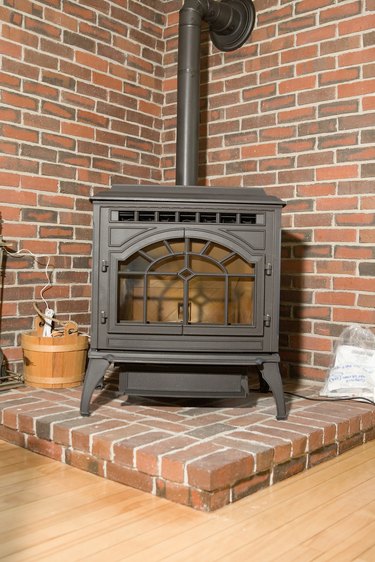 Stove pipe must change to chimney pipe when it enters the wall. Image Credit: Jupiterimages/Photos.com/Getty Images
Stove pipe must change to chimney pipe when it enters the wall. Image Credit: Jupiterimages/Photos.com/Getty Images
Double wall chimney pipes are designed to protect buildings from high temperatures generated by some heating appliances. These pipes only need a 2-inch clearance to combustibles because they remain cool on the outside, while their internal design allows them to withstand temperatures as high as 1,700 or 2,100 degrees Fahrenheit for a limited time.
Video of the Day
Pipe Types
Some homeowners are confused about the difference between chimney pipe and stovepipe. Both types of pipe are available as double wall, but stovepipe can’t withstand the same high temperatures that chimney pipes are designed to tolerate. It can become even more confusing when you start talking about flue vents, which are a type of thin-walled metal chimney used to vent oil or gas appliances. Double wall flue vents are also available.
Class A
Double wall chimney pipe is made from galvanized or stainless steel with some kind of insulation, such as fiberglass or asbestos, packed between the walls. Unlike stovepipe, it can pass through walls and ceilings. Class A chimney pipe is used to vent fireplaces, boilers and furnaces that burn oil, wood or coal, and must meet Underwriter Laboratory standards for factory built chimneys. This standard, which is known as UL 103 mandates that Class A chimneys be designed to operate at a continuous temperature of 1,000 degrees Fahrenheit. In addition, the chimney must be able to run for one hour at 1,400 degrees Fahrenheit and pass three ten-minute chimney fire tests at either 1,700 or 2,100 degrees Fahrenheit, depending on their rating.
Flue Vents
Type B double wall flue vents are used to vent gas appliances that produce flue gases no higher than 480 degrees Fahrenheit, while L-vents usually vent oil furnaces that produce gases no higher than 570 degrees Fahrenheit. B-vents must never be used with anything except LP or natural gas. Some manufacturers state that their L-vents are tested to withstand a 10-minute fire at 1,700 degrees.
Stove Pipe
Double wall stovepipe is used to connect wood burning stoves to the chimney and is only meant to be used in the same room where the stove is located. Since building codes don’t allow it to pass through a wall or a ceiling, it has to be converted to class A chimney pipe when it reaches the wall or ceiling. Double wall stovepipe is made with a stainless steel inner wall and a steel outer wall that’s painted black. It uses air to insulate the second wall, which improves draft and efficiency.



























